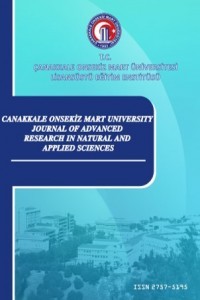Makine Öğrenmesi Yöntemleri ile Türkiye’de Covid-19’a İlişkin Günlük Vaka, Ağır Hasta, Vefat ve İyileşen Sayısı Tahmini
Covid-19, makine öğrenmesi, en küçük kareler polinom uyumu, kübik eğri uyumu, polinom regresyon
Estimation of Daily Cases, Deaths, Serious Patients and Recovering Patients of Covid-19 in Turkey with Machine Learning Methods
Covid 19, machine learning, cubic spline fit, least squares polynomial fit, polynomial regression,
___
- Aggarwal, C. C. (2018). Neural Networks and Deep Learning. Springer.
- ArunKumar, K. E., Kalaga, D. V., Sai Kumar, C. M., Chilkoor, G., Kawaji, M., ve Brenza, T. M. (2021). Forecasting the dynamics of cumulative COVID-19 cases (confirmed, recovered and deaths) for top-16 countries using statistical machine learning models: Auto-Regressive Integrated Moving Average (ARIMA) and Seasonal Auto-Regressive Integrated Moving Averag. Applied Soft Computing, 103(December 2019), 107161. https://doi.org/10.1016/j.asoc.2021.107161
- Bhadana, V., Jalal, A. S., ve Pathak, P. (2020). A Comparative Study of Machine Learning Models for Covid-19 Prediction in India. IEEE 4th Conference on Information ve Communication Technology (CICT). https://doi.org/10.1109/CICT51604.2020.9312112
- Dos Santos Gomes, D. C., ve De Oliveira Serra, G. L. (2021). Machine Learning Model for Computational Tracking and Forecasting the COVID-19 Dynamic Propagation. IEEE Journal of Biomedical and Health Informatics, 25(3), 615–622. https://doi.org/10.1109/JBHI.2021.3052134
- Ertel, W. (2017). Introduction to Artificial Intelligence (2. baskı). Springer.
- Gambhir, E., Jain, R., Gupta, A., ve Tomer, U. (2020). Regression Analysis of COVID-19 using Machine Learning Algorithms. 2020 International Conference on Smart Electronics and Communication, Icosec, 65–71. https://doi.org/10.1109/ICOSEC49089.2020.9215356
- Gupta, V. K., Gupta, A., Kumar, D., ve Sardana, A. (2021). Prediction of COVID-19 confirmed, death, and cured cases in India using random forest model. Big Data Mining and Analytics, 4(2), 116–123. https://doi.org/10.26599/BDMA.2020.9020016
- Harrell Jr., F. E. (2015). Regression Modeling Strategies (2. baskı). Springer.
- Hazarika, B. B., ve Gupta, D. (2020). Modelling and forecasting of COVID-19 spread using wavelet-coupled random vector functional link networks. Applied Soft Computing Journal, 96, 106626. https://doi.org/10.1016/j.asoc.2020.106626 Kumar, N., ve Susan, S. (2021). Particle swarm optimization of partitions and fuzzy order for fuzzy time series forecasting of COVID-19. Applied Soft Computing, 110, 107611. https://doi.org/10.1016/j.asoc.2021.107611
- Kumari, R., Kumar, S., Poonia, R. C., Singh, V., Raja, L., Bhatnagar, V., ve Agarwal, P. (2021). Analysis and predictions of spread, recovery, and death caused by COVID-19 in India. Big Data Mining and Analytics, 4(2), 65–75. https://doi.org/10.26599/BDMA.2020.9020013
- Kurniawan, R., Abdullah, S. N. H. S., Lestari, F., Nazri, M. Z. A., Mujahidin, A., ve Adnan, N. (2020). Clustering and Correlation Methods for Predicting Coronavirus COVID-19 Risk Analysis in Pandemic Countries. 2020 8th International Conference on Cyber and IT Service Management, CITSM 2020. https://doi.org/10.1109/CITSM50537.2020.9268920
- Leon, M. I., Iqbal, M. I., Azim, S. M., ve Al Mamun, K. A. (2021). Predicting COVID-19 infections and deaths in Bangladesh using Machine Learning Algorithms. 2021 International Conference on Information and Communication Technology for Sustainable Development, ICICT4SD 2021 - Proceedings, 70–75. https://doi.org/10.1109/ICICT4SD50815.2021.9396820
- Mandayam, A. U., Rakshith, A. C., Siddesha, S., ve Niranjan, S. K. (2020). Prediction of Covid-19 pandemic based on Regression. Proceedings - 2020 5th International Conference on Research in Computational Intelligence and Communication Networks, ICRCICN 2020, 1–5. https://doi.org/10.1109/ICRCICN50933.2020.9296175
- Ramchandani, A., Fan, C., ve Mostafavi, A. (2020). DeepCOVIDNet: An Interpretable Deep Learning Model for Predictive Surveillance of COVID-19 Using Heterogeneous Features and Their Interactions. IEEE Access, 8, 159915–159930. https://doi.org/10.1109/ACCESS.2020.3019989
- Rustam, F., Reshi, A. A., Mehmood, A., Ullah, S., On, B. W., Aslam, W., ve Choi, G. S. (2020). COVID-19 Future Forecasting Using Supervised Machine Learning Models. IEEE Access, 8, 101489–101499. https://doi.org/10.1109/ACCESS.2020.2997311
- Sevli, O., ve Başer, V. G. (2020). Covid- 19 Salgınına Yönelik Zaman Serisi Verileri ile Prophet Model Kullanarak Makine Öğrenmesi Temelli Vaka Tahminlemesi Machine Learning Based Case Estimation Using Prophet Model with Time Series Data for Covid-19 Outbreak. 19, 827–835. https://doi.org/10.31590/ejosat.766623
- Singh, M., ve Dalmia, S. (2020). Prediction of number of fatalities due to Covid-19 using Machine Learning. 2020 IEEE 17th India Council International Conference, INDICON 2020. https://doi.org/10.1109/INDICON49873.2020.9342390
- T.C. Sağlık Bakanlığı. (2021). Covid 19. https://covid19.saglik.gov.tr/
- Theodoridis, S., ve Koutroumbas, K. (2009). Pattern Recognition (4th Editio). Academic Press, Elsevier.
- Vakula Rani, J., ve Jakka, A. (2020). Forecasting COVID-19 cases in India using machine learning models. Proceedings of the International Conference on Smart Technologies in Computing, Electrical and Electronics, ICSTCEE 2020, 466–471. https://doi.org/10.1109/ICSTCEE49637.2020.9276852
- World Health Organization. (2021). Data Table. https://covid19.who.int/
- Yang, Z., ve Chen, K. (2020). Machine Learning Methods on COVID-19 Situation Prediction. Proceedings - 2020 International Conference on Artificial Intelligence and Computer Engineering, ICAICE 2020, 78–83. https://doi.org/10.1109/ICAICE51518.2020.00021
- Yudistira, N., Sumitro, S. B., Nahas, A., ve Riama, N. F. (2021). Learning where to look for COVID-19 growth: Multivariate analysis of COVID-19 cases over time using explainable convolution–LSTM. Applied Soft Computing, 109, 107469. https://doi.org/10.1016/j.asoc.2021.107469
- Yayın Aralığı: Yılda 4 Sayı
- Başlangıç: 2015
- Yayıncı: Çanakkale Onsekiz Mart Üniversitesi
Şehmus FİDAN, Ömer Ali KARAMAN, Abdullah YILDIRMAZ
Improving The Physical Stability Of Virgin Olive Oil Mayonnaise
Melis COSKUN, Sinem ARGUN, Emrah KIRTIL
Büşra CİCİ, Beyhan PEKEY, Simge TANER ÇANKAYA
Evaluation of Consumers' Aspects on Organic Farming Products by Regions
Başak AYDIN, Murat DOĞU, Ayten AŞKIN KILINÇ, Sunay DEMİR, Bülent TARIM, Duygu AKTÜRK, Filiz PEZİKOĞLU, Volkan BURUCU, Mustafa ASLAN
Effect of Grovth Medium on L-Dopa and Dopamine Production Using Citrobacter freundii (NRRL B-2643)
Meltem ÇAKMAK, Veyis SELEN, Dursun ÖZER, Fikret KARATAŞ, Sinan SAYDAM
Group-Based Authentication Methods in The OneM2M Ecosystem
İbrahim Uğur ABA, Erhan TAŞKIN
Nihan ERCİOĞLU AKDOĞAN, Elif UBAY
Comparative analysis and manufacturing of airfoil structures suitable for use at low speeds
